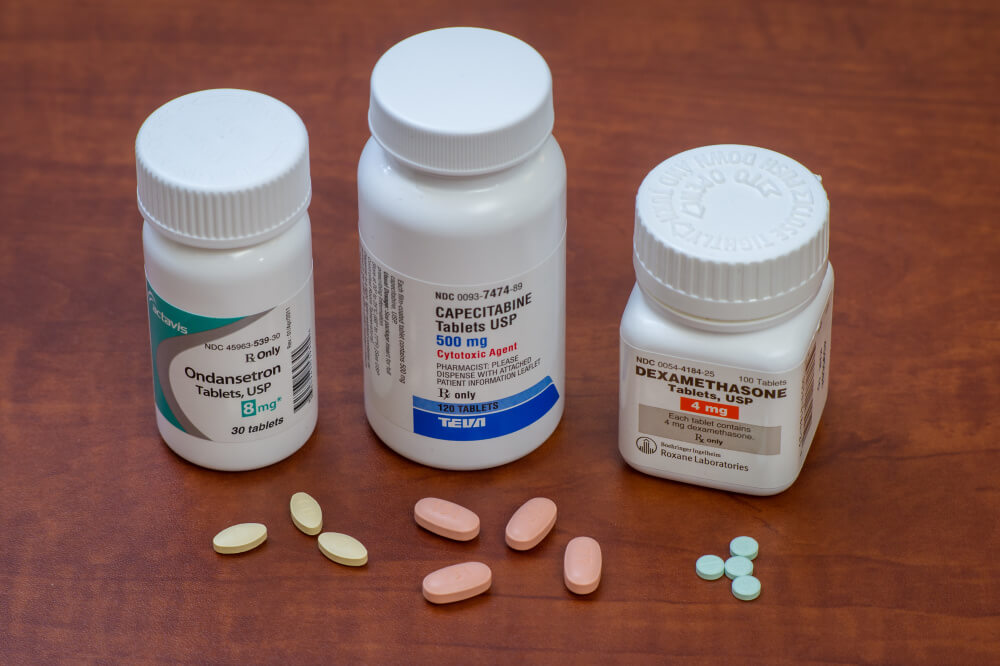Every cancer patient is different, and there are many different types of cancer treatment that a patient may receive—all of which is dependent on their unique circumstances. A patient may only receive one type of treatment or a combination of multiple different treatments.
Treatment can also have different goals. In some cases, treatment is used in an effort to eliminate or control the growth of cancer in the body. In other cases, treatment may be palliative, with the aim of reducing symptoms and improving the patient’s overall quality of life. Everything depends on what kind of cancer the patient has and how advanced it is.
Here are a few common types of cancer treatment and how they are generally used.
Chemotherapy
Chemotherapy consists of powerful drugs that aim to kill or destroy cancer cells to stop them from growing and spreading in the body.
There are over 100 different types of chemotherapy drugs, all which serve a different purpose. Some drugs may cause damage to a cancer cell’s DNA, causing them to die off; others bind the cell’s DNA to stop them from dividing. During treatment, a patient may receive just one kind of drug alone, but patients often undergo a combination of different drugs.

Patients most commonly receive chemo by injection or mouth; the drugs then travel through the body’s bloodstream, which can cause side effects. These often include nausea, vomiting, short-term hair loss, fatigue, and an increased risk of infections.
Radiation
Radiation therapy uses high doses of targeted radiation to kill cancer cells and shrink tumors. As is the case with chemo, the purpose of using radiation is to damage the DNA of cancer cells to slow down or stop their growth while leaving the surrounding tissue healthy.
Unlike chemo, radiation therapy is often localized. Receiving local therapy means that only a specific part of your body is receiving treatment. Because the radiation is only aimed at the part of a patient’s body that is cancerous, only that portion of their body will be affected.
Radiation therapy comes in two forms: external beam radiation therapy and internal radiation therapy. External beam radiation is delivered through a machine that aims the radiation at the cancerous part of the body. Internal radiation, also known as brachytherapy, works by implanting radiated seeds or capsules on or near the tumor. Radiation can also be given in liquid form; in this case, it is received orally or intravenously and travels through the bloodstream.

Surgery
Surgery is used to physically remove all, or a portion of, a patient’s cancerous tissue. This treatment is most effective when the cancer is a solid tumor that is contained to one area. There are many different types of surgeries that a patient may undergo, depending on their cancer.
Curative surgery is used when the cancer is only in a single part of the body and can be removed completely. Since the tumor may be entirely removed, this may be the only form of treatment a patient needs.
Surgery to debulk a tumor removes only a portion of the cancerous tissue. The rest of the tumor that remains would then be treated with chemo, radiation, or other forms of treatment. Tumor debulking typically occurs when it is likely that removing the entire tumor could cause damage to healthy organs and tissues surrounding it.
Palliative surgery is often used for those with advanced cancer. This kind of surgery is used to relieve a patient of discomfort or pain induced by their cancer. It cannot cure the cancer, but it helps ease the problems the cancer causes.
Restorative surgery aims to address the impact major surgery can have on a person’s appearance after a major surgery. A common example is breast reconstruction, which has the goal of recreating breast symmetry after a patient has a mastectomy.
Preventative surgery is performed to remove tissue that is likely to become cancerous, even if it currently is not. For example, women who have inherited the breast cancer gene (BRCA1 or BRCA2), have an increased risk of developing breast cancer. As a result, some women decide to undergo a mastectomy to lower their risk.
Other forms of treatment include:
- Immunotherapy—treatments that use the body’s own immune system to combat diseases.
- Hormone therapy—therapies that block hormones that spur certain cancers to grow.
- Targeted therapy—therapies that take aim at the specific genetic changes and the proteins within cancer cells that drive their chaotic growth.
- Stem cell transplant —an infusion of healthy stem cells used to treat several types of blood cancers and other blood disorders.
